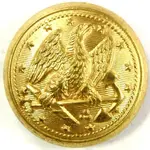Ajaj said:
> I'm thinking it's military and not civilian because of its detail;
> I've never seen one with such detail mimicing a navy button.
Actually, the amount of detail on that button is far below the level of fine detail shown on a genuine US Navy uniform button. For example, you can't see any of the "short" feathers in the eagle's wing. Compare yours with the multitude of sharply visible "short" feathers on an actual US Navy button in the photo below.
One other disqualifying clue is that (as the photo shows) on this 1852-1941 version US Navy button the rope border always passes through the ring on the anchor's top. But not on your button.
> However, I cannot find an Albert's number for it from my book.
The Alphaeus H. Albert button-book of course can't show every version we now know exists... but in general, when a "navy" button cannot be found in Albert, that means it is not an actual US Navy button.
> Keep in mind I have an earlier edition (1976).
The 1976 edition, a.k.a. Bicentennial Edition, is the final edition... which has a Supplement in the very back, consisting of many pages of newly-discovered buttons. It has 511 pages. Does that match up with yours?
> The back of the button does not have any company name and is kind of a half birdcage design. Thoughts?
Your button's iron/steel back has what button-collectors call a "pierced-dome" self-shank back -- which was invented and US-Patented sometime around 1910. (I can't recall the very-exact year of the Patent.)
BTW, actual US Navy buttons never have an iron back, because the very-humid salty ocean air causes the back to rust quickly, making a stain on the uniform. The sole exception to that rule is a very rare civil war era ironbacked US Navy kepi-hat strap button. A rust-stain will not show up on the hat's leather strap.






